When choosing an engagement ring, there are several elements of design to consider. The most important ones are your choice of diamond, the ring design, the ring setting and your choice of metal. We have included some information below about these design elements to assist you to make an informed choice.
We will be happy to answer any further queries you may have, in order to facilitate your decision in obtaining your desired engagement ring.
- Choosing a diamond
- Choosing an engagement ring design
- Choosing an engagement ring setting
- Choosing the metal
Choosing a diamond
For most people, choosing the diamond is the starting point of designing their engagement ring. On average up to 70% of the cost of the engagement ring will be devoted to buying the diamond. Having a budget will set parameters for the wide choice of diamonds that are available. To find out about the variety of diamonds that are commonly used in engagement rings read our education page on Diamonds.
You can also read Learn About Diamonds to discover additional information about diamonds, such as the 4 Cs – colour, cut, clarity and carat.
Choosing an engagement ring design
Once the diamond has been decided upon, you will be able to choose the design of your engagement ring. If you need ideas, you can view our picture Gallery which has a wide range of rings. Keep in mind that the rings can be modified to suit your preferences. During a free consultation you can try the rings on and clarify aspects of your ideal engagement ring design.
If you have an idea or an image of your preferred engagement ring design, we can discuss details of your vision.
At Raffini Jewellers we welcome the opportunity to discuss your ideas and provide you with an obligation free quote for your engagement ring.
Choosing an engagement ring setting
The setting of the ring refers to the way in which the diamond is held in place onto the ring. The shape of the diamond and the setting style give the ring its distinctive appearance. The style of the setting is crucial in order to present the diamond in its optimal appearance. The choice is quite personal and your preference will ultimately determine the ideal setting style for you.
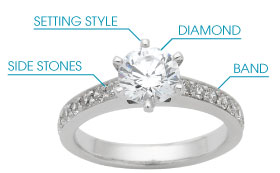
Below are some of the most popular setting styles.
Claw Setting:
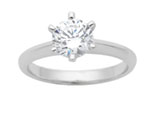 Claw setting is by far the most sought after style of setting chosen for Engagement Rings. It is often used in solitaire designs where the centre diamond is the main feature of the jewellery piece. It consists of a set of claws that overlap the edge of the Diamond and secure it firmly into the setting. Claw settings come in variations, such as 6 claws (usually for larger diamonds) or 4 claws (often used for square diamonds). Claws are the ideal setting for a Brilliant cut diamond as it becomes visible from every angle, while remaining securely held in its setting. 3 claws settings are mainly used for heart shapes, Pear shapes and Trillian cut diamonds, while the 2 claws are mainly used to set marquise shape diamonds. The tips of the claws are given either round finish or a pointy look (like pear shape), depending on the design.
Claw setting is by far the most sought after style of setting chosen for Engagement Rings. It is often used in solitaire designs where the centre diamond is the main feature of the jewellery piece. It consists of a set of claws that overlap the edge of the Diamond and secure it firmly into the setting. Claw settings come in variations, such as 6 claws (usually for larger diamonds) or 4 claws (often used for square diamonds). Claws are the ideal setting for a Brilliant cut diamond as it becomes visible from every angle, while remaining securely held in its setting. 3 claws settings are mainly used for heart shapes, Pear shapes and Trillian cut diamonds, while the 2 claws are mainly used to set marquise shape diamonds. The tips of the claws are given either round finish or a pointy look (like pear shape), depending on the design.
Channel Setting:
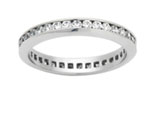 Channel Setting is the ideal setting style for wedding bands that need to complement engagement rings, by contributing to their elegance. This style is most effective in wedding rings and eternity rings where diamonds are set side by side, and held in firmly by two parallel lines of metals, giving the impression of a continuous flow of diamonds. However, in order to achieve this appearance, it is important for the stones to be of the exact same size, width and weight. Channel setting style can accommodate most cuts, from round brilliant cuts, princess cuts, Asher cuts and baguettes.
Channel Setting is the ideal setting style for wedding bands that need to complement engagement rings, by contributing to their elegance. This style is most effective in wedding rings and eternity rings where diamonds are set side by side, and held in firmly by two parallel lines of metals, giving the impression of a continuous flow of diamonds. However, in order to achieve this appearance, it is important for the stones to be of the exact same size, width and weight. Channel setting style can accommodate most cuts, from round brilliant cuts, princess cuts, Asher cuts and baguettes.
Pavé Setting:
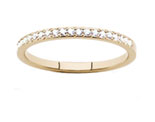
Pavé setting (also referred to as Grain setting or Bead setting) is the oldest style of setting of all. It is an impressive style of setting achieved optimally with small diamonds. The diamonds are placed next to each other, with minimum gaps in between, and held securely by raising tiny gold metal beads around them. The effect is astonishing, especially if the design is with multiple rows, transforming the ring into a sea of diamonds. Also, the edges of the pave setting ring can be mill-grained finished (serrated edges), giving the feel of a vintage style. This style of setting is commonly used to fill up the surface of a jewellery piece with small diamonds, making the metal less visible.
Bezel Setting:
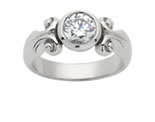 Bezel settings are the safest option when seeking total protection for a diamond against knocks and chips, while pursuing an elegant look. The centre stone is surrounded with metal, securing it firmly into the setting. Bezel setting style is quite versatile and can accommodate all cuts and tastes. You can either have full Bezel (the stone is fully covered with metal), or half Bezel (the stone is surrounded with metal from only two sides). The half bezel style allows the stone to be more visible to the viewer. Coloured gemstones are often set in bezel as it gives extra protection against accidental damage.
Bezel settings are the safest option when seeking total protection for a diamond against knocks and chips, while pursuing an elegant look. The centre stone is surrounded with metal, securing it firmly into the setting. Bezel setting style is quite versatile and can accommodate all cuts and tastes. You can either have full Bezel (the stone is fully covered with metal), or half Bezel (the stone is surrounded with metal from only two sides). The half bezel style allows the stone to be more visible to the viewer. Coloured gemstones are often set in bezel as it gives extra protection against accidental damage.
Bezel setting is often used for in engagement rings, earrings and pendants.
Flush setting:
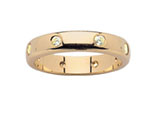 Flush setting, also known as hammer setting, is an impressive technique where the diamonds are imbedded into the metal. The stone is covered up to the girdle depth, leaving the crown elevated from the surface of the metal. As with most setting styles, flush setting demands high skill and perfection from a jeweller performing this kind of setting. The gaps between stones should be evenly spaced, and set in such a way that they are not sunk into the metal, rather much closer to the surface. Flush setting is ideal in a plain wedding ring or to accent a solitaire engagement ring.
Flush setting, also known as hammer setting, is an impressive technique where the diamonds are imbedded into the metal. The stone is covered up to the girdle depth, leaving the crown elevated from the surface of the metal. As with most setting styles, flush setting demands high skill and perfection from a jeweller performing this kind of setting. The gaps between stones should be evenly spaced, and set in such a way that they are not sunk into the metal, rather much closer to the surface. Flush setting is ideal in a plain wedding ring or to accent a solitaire engagement ring.
Choosing the metal
You will also need to decide what metal to have your engagement ring made in. Options include gold (yellow or white) and platinum. To learn about these metals read about White Gold, Yellow Gold and Platinum. As a general guide, most people choose the colour of the metal based on the jewellery they commonly wear. If you wear both colours, you may wish to consider an engagement ring with a combination of white and yellow metals.
Read about the difference between White Gold and Platinum to discover the advantages and disadvantages of both metals.
You may also like read about the difference between 9 carat gold and 18 carat gold, to help you decide which carat to have your jewellery made in.